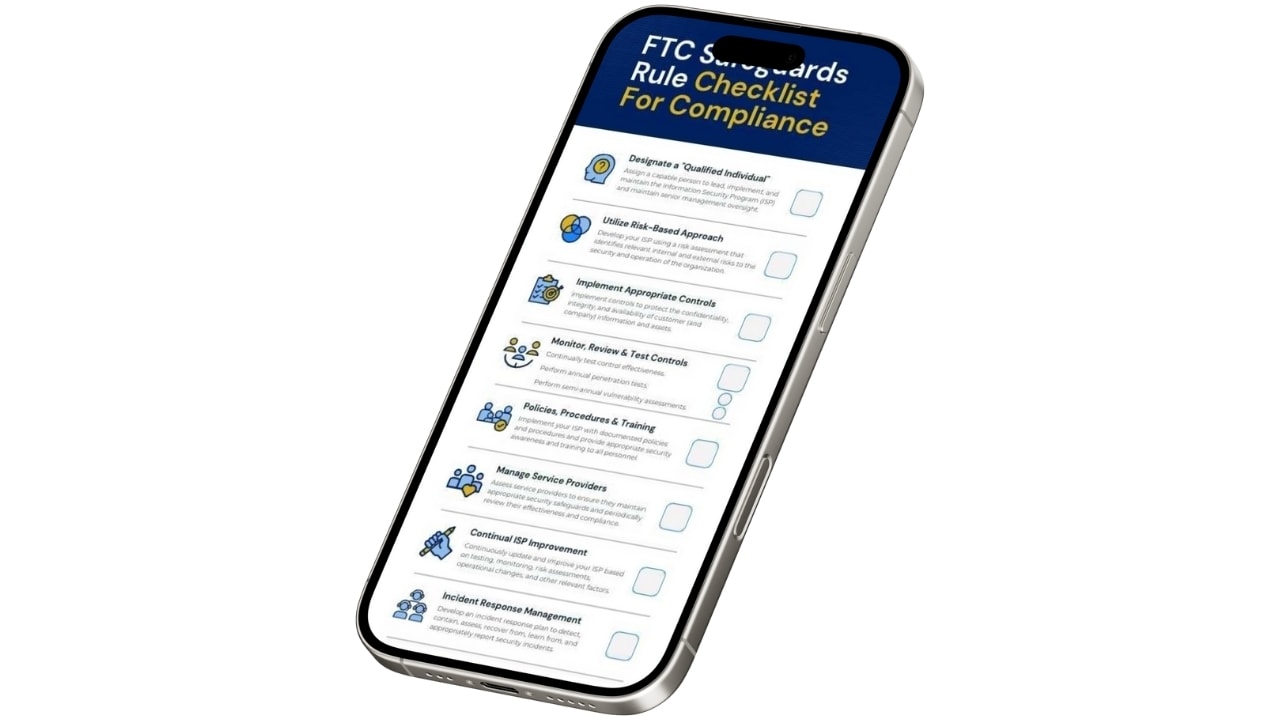FTC Safeguards Rule Checklist for Compliance: Managing Service Providers
Apr 10, 2025
When most businesses think about cybersecurity, their minds go straight to firewalls, strong passwords, and those mildly threatening posters in the breakroom about phishing emails. But what about the folks outside your walls—your service providers?
From your cloud storage provider to your payroll company to that “totally secure” third-party IT team, these vendors may have access to your customers' sensitive data. And under the FTC Safeguards Rule, that makes them your responsibility.
That’s right—your compliance status is tied to their security posture. So unless you’ve got some magical vendor fairy ensuring every third party is locked down tight (and we’d love to meet them), this part of the Rule deserves your full attention.
In this article, we’ll walk you through § 314.4(f) – Appropriately Manage Service Providers, what it actually requires, what “reasonable oversight” looks like, and how you can tackle it without losing your mind (or your audit readiness).
Let’s dig in—because compliance may be mandatory, but confusion doesn’t have to be.
Introduction to the Checklist Series
In today's digital age, data security is paramount. Businesses must ensure that they are compliant with the latest regulations to protect customer information. This is where our comprehensive checklist series comes in. Designed to help businesses navigate the complex landscape of data security, our checklists provide actionable steps to ensure compliance and safeguard sensitive information.
The purpose of this checklist series is to offer concrete guidance to businesses. By breaking down the requirements of the FTC's Safeguards Rule, we provide specific safeguards that companies can implement to protect customer information. This ensures adherence to core data security principles while allowing flexibility according to operational needs.
Follow Along with the FTC Safeguards Rule Compliance Checklist

This article is part of our ongoing FTC Safeguards Rule Compliance Checklist series, built to guide you through each major requirement of the Rule—one manageable step at a time. If you need a practical way to stay on top of your progress, we’ve created a visual checklist and infographic that lays out the essential controls in a simple, follow-along format—offering clear direction on how to safeguard customer data effectively.
Whether you’re starting your security program from the ground up or just fine-tuning things before an audit, our checklist keeps you structured, focused, and confidently aligned with compliance requirements.
👉 Download the FTC Safeguards Rule Checklist Infographic to follow along as you read.
What Is the FTC Safeguards Rule?
The Federal Trade Commission (FTC) Safeguards Rule, born from the Gramm-Leach-Bliley Act (GLBA), is all about one thing: keeping consumer financial data safe.
Initially adopted in 2003, the Rule received a substantial upgrade in 2021 to reflect today’s much more hostile cyber landscape. With compliance deadlines hitting in mid-2023, it’s not just about checking a box—it’s about having a documented, enforceable, and risk-based cybersecurity program.
The goal? The goal is to safeguard Nonpublic Personal Information (NPI)—that is, sensitive customer data—by putting in place administrative, technical, and physical measures designed to block unauthorized access, misuse, or exposure.
Who Has to Comply?
Let’s clear up a common misconception: you don’t have to be a bank to fall under this rule.
If you’re in a business that’s even adjacent to handling financial data, you’re probably considered a “financial institution” under the FTC’s definition. These covered financial institutions must develop and maintain information security programs to protect customer information. This includes:
-
Tax preparers and CPA firms
-
Mortgage lenders and brokers
-
Auto dealerships that offer financing
-
Payday and title lenders
-
Credit repair companies
-
Non-SEC regulated investment advisors
-
Personal property appraisers
If your organization collects, stores, or transmits customer financial information—you’re in the hot seat.
📋 FTC Safeguards Rule: Core Requirements
Here’s the big picture. To comply with the Rule, the safeguards rule requires you to:
-
Designate a “Qualified Individual” to oversee information security (16 CFR § 314.4(a))
-
Using a risk-based approach, design your information security program and be sure it is fully documented with a written information security plan (16 CFR § 314.4(b))
-
Implement security controls to mitigate risks (16 CFR § 314.4(c))
-
Monitor, review, and test security measures regularly (16 CFR § 314.4(d))
-
Establish policies, procedures, and security training (16 CFR § 314.4(e))
-
Appropriately manage service providers (suppliers, vendors, consultants, etc.) and their contracts (that must include security safeguard considerations) to ensure compliance (16 CFR § 314.4(f))
-
Continuously improve the ISP based on findings (16 CFR § 314.4(g))
-
Have a documented incident response plan to address security events (16 CFR § 314.4(h))
-
Meet breach notification requirements
-
Provide written security reports to the board (16 CFR § 314.4(i))
Deep Dive: 16 CFR § 314.4(f) – Appropriately Manage Service Providers

When it comes to cybersecurity, you’re only as secure as your weakest link. And if you’re outsourcing any services, you’ve handed parts of your risk surface to someone else. Enter § 314.4(f)—your official marching orders for overseeing service provider arrangements.
This part of the Rule breaks oversight into three core actions. Let’s unpack each one—and make it actionable.
Select and Retain Service Providers with Appropriate Safeguards
Reg Text:“Take reasonable steps to select and retain service providers that are capable of maintaining appropriate safeguards for the customer information at issue.”
Translation: Don’t just go with the vendor that replies fastest or offers the best price. You need to ensure they will appropriately manage sensitive data and only allow authorized users to access sensitive customer information.
Here’s what “reasonable steps” look like:
-
Vendor questionnaires or security risk surveys
-
Requesting SOC 2, ISO 27001, or other third-party audit reports
-
Reviewing privacy policies and data handling procedures
-
Checking breach history or reputation (a quick Google goes a long way)
-
Regularly monitor service providers to ensure ongoing compliance with security standards
🔍 Pro Tip: Use a vendor intake form and scoring matrix to standardize your evaluation process.
How Input Output Can Help:We provide vendor due diligence templates, third-party security review checklists, and can even perform vendor assessments for you. So, instead of guessing whether a provider is secure, you’ll know.
Require Safeguards in your Supplier Contract
Reg Text:“Contractually require your suppliers and vendors to implement and maintain appropriate information security practices and safeguards.”
This is the “we put it in writing” part. Because if your vendor mishandles customer data, and you didn’t contractually obligate them to protect it through a comprehensive security policy, guess who’s holding the compliance bag?
(Hint: it’s you.)
📝 What These Contracts Should Include:
-
Clear language requiring compliance with applicable laws (like the GLBA and the Safeguards Rule)
-
Data security and privacy obligations (e.g., encryption standards, breach notification timelines)
-
Right-to-audit clauses
-
Termination clauses for security non-compliance
-
Confidentiality clauses
-
The supplier's responsibilities in maintaining and safeguarding customer information, including implementing appropriate security measures and conducting regular monitoring
How Input Output Can Help: We provide information security policy guidance to ensure you’re covered. We’ll even review your vendor contracts as part of a gap assessment.
Periodically Assess Your Suppliers and Associated Information Systems

Reg Text:“Periodically assess your providers based on the risk they present and the continued adequacy of their safeguards.”
Initial vetting isn’t enough. Your vendors’ risk profiles—and your risk tolerance—can change. That’s why continuous monitoring is required.
🔄 What Periodic Assessment Looks Like:
-
Annual or bi-annual security reassessments (more often for high-risk vendors)
-
Updated questionnaires
-
Reviewing updated SOC 2 or ISO audit reports
-
Scanning for news of breaches or incidents involving your vendors
-
Confirming they’re still meeting your contractual requirements
-
Documentation of these efforts in your written risk assessment
🔁 Frequency Should Match Risk:
-
High-risk providers (e.g., those handling NPI directly): Reassess annually or more frequently based on the risks identified
-
Low-risk providers: Reassess every 2 years, or upon major changes based on the identified risks
How Input Output Can Help: Our auditing services and ongoing vendor management check-ins make it easy to stay on top of your provider oversight. We can even help automate these touchpoints with your vendors.
Why This All Matters: Real-World Risk
Consider this: A third-party payroll processor gets hacked and exposes your clients’ banking data. This incident highlights significant security risks, including potential vulnerabilities in your information security policies.
Your clients won’t blame the processor. They’ll blame you.
Why? Because you were supposed to make sure your vendors were secure.
The FTC doesn’t distinguish between “my vendor messed up” and “I dropped the ball”—if you’re not managing your service providers, you’re not compliant.
🧰 How Input Output Can Help
Staying on top of vendor management isn’t easy, especially when you’re already buried under security to-dos. That’s where we come in.
Here’s how we can help you with risk management and cover all three areas of 314.4(f)—and then some:
📄 Policy Templates & Contract Language
-
Vendor Management Policy Template
-
Data Processing & Confidentiality Agreement Clauses
-
Due Diligence Forms
-
Clear access permissions: Ensure that access permissions are clearly defined and only granted to individuals with a legitimate business need. This helps secure information systems against unauthorized use while supporting necessary access for authorized personnel.
🔎 Risk & Gap Assessments
-
Evaluate your current vendor management practices
-
Identify foreseeable risks to understand potential threats to the security, confidentiality, and integrity of customer information
-
Identify where you fall short of FTC expectations
-
Provide prioritized, actionable fixes
📊 Ongoing Oversight Tools
-
Reassessment templates
-
Third-party audit support
-
Annual review frameworks to ensure secure access to the organization's network
🎓 Security Awareness & Social Engineering Training
-
Fully managed employee training programs to address emerging threats
-
Simulated phishing, vishing, smishing, and baiting campaigns
-
Trackable results and compliance reporting
✅ Full WISP Development
-
From scratch or policy reviews—we help you build or refine a compliant Written Information Security Program (WISP). Our approach ensures that your information system is designed and implemented securely, managing and protecting customer data effectively.
Don’t want to do this alone? Schedule a time with us. We’ll help you get compliant and stay that way—without the migraines.
Conclusion: Your Vendors, Your Risk

Managing service providers isn’t just a compliance requirement—it’s a business-critical function. With data breaches on the rise, regulators are watching closely. If your vendor drops the ball, you’re the one answering for it. Regular reviews and assessments of your company's compliance with Section 314.4 of the Safeguards Rule are essential. The Qualified Individual must provide an ongoing assessment to ensure effective security measures and response plans are maintained.
To recap, here’s what you need to do:
-
Vet your service providers before you work with them
-
Put clear security obligations in your contracts
-
Check in regularly to make sure they’re still doing their job
The good news? With the right policies, procedures, and support—you can make all of this part of your regular information security operations. With Input Output by your side, you don’t have to figure it out alone.
Don’t forget your checklist! 👉 Download our FTC Safeguards Rule Checklist
Make things easier on yourself. Let us do the heavy lifting,… or at least spot you!
📅 Schedule a consultation
STAY INFORMED
Subscribe now to receive the latest expert insights on cybersecurity, compliance, and business management delivered straight to your inbox.
We hate SPAM. We will never sell your information, for any reason.


